| Srl | Item |
| 1 |
ID:
141215
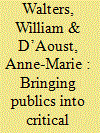

|
|
|
|
|
| Summary/Abstract |
Publics are an undertheorised and somewhat marginal presence in critical security studies. This article argues that a better understanding of publics can advance our understanding of the governance as well as the contestation of security regimes and practices. We develop this argument in three parts. First, we discuss the marginality of publics in critical security studies while highlighting those limited instances where publics have been engaged. Second, we direct attention to emerging research on publics in cognate disciplines, focusing in particular on the literature about material publics. We distil from this work some useful lessons for security studies. In a final section we suggest two research moves for promoting a stronger focus on publics within critical security studies. We conclude that a focus on material publics can furnish security studies with a better understanding of the phenomenon of politics.
|
|
|
|
|
|
|
|
|
|
|
|
|
|
|
|
| 2 |
ID:
073521
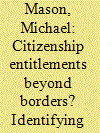

|
|
|
|
|
| Publication |
2006.
|
| Summary/Abstract |
argue that although environmental law is state centric in nature, there is a growing body of international environmental law that allows at least some input from public actors in implementing key substantive and procedural obligations. The evolution of these environmental entitlements is linked to the global diffusion of democratic norms of civic participation, the application of the nondiscrimination principle in both public and private international law, and the cosmopolitan reach of human rights claims. It is at the intersection of individual and nongovernmental organization (NGO) rights with interstate obligations that transnational citizenship entitlements are emerging¾notably equal opportunities for access and redress for affected publics. I critically survey relevant multilateral environmental agreements to gauge the significance of rule making bestowing entitlements on publics affected by transboundary and global environmental harm.
|
|
|
|
|
|
|
|
|
|
|
|
|
|
|
|
| 3 |
ID:
140456
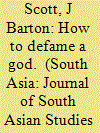

|
|
|
|
|
| Summary/Abstract |
This article argues that competing ideas about the nature of public selfhood structured the Maharaj Libel Case, as well as colonial publics more broadly. Jadunathji Maharaj had, in effect, lost his libel suit even before it went to court. For libel law, the essence of the human person is a private self that owns various forms of property, including the public persona known as ‘reputation’. For the Hindu Pushtimarg, meanwhile, the Maharaj was considered an incarnation of Krishna; his religious or public self preceded and was the ontological ground for his merely personal being. To compare these two conceptualisations of the self is to see how selfhood became an important site for the articulation of the public in colonial India.
|
|
|
|
|
|
|
|
|
|
|
|
|
|
|
|
| 4 |
ID:
164870
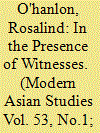

|
|
|
|
|
| Summary/Abstract |
British observers of the nineteenth-century panchayat were convinced that it represented a judicial forum of great antiquity, in which petitioners were able to gain local and direct access to justice. They contrasted the panchayat favourably with the delays and frustrations that beset the eighteenth-century East India Company's attempts to channel all petitions through its own courts. This article examines the history of the pre-colonial panchayat in western India and its early modern predecessors. During the early modern centuries, a diverse array of state-level and local corporate bodies made up the landscape for the submission of petitions and the hearing of suits. Although many suits were local in nature, the process of hearing and adjudication itself gave these judicial spaces a significant ‘public’ dimension, and their forms of argumentation frequently invoked general principles of justice and moral order. From the early eighteenth century, the new form of the panchayat came to supersede these older corporate bodies and to reshape the forms of public that gathered around them. The Maratha state, based in Pune, sought firmer control over revenue and justice. State officials promoted the panchayat as a new type of judicial arena, weakening the local corporate institutions and tying them more closely to the Pune court.
|
|
|
|
|
|
|
|
|
|
|
|
|
|
|
|
| 5 |
ID:
164911
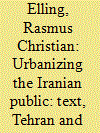

|
|
|
|
|
| Summary/Abstract |
By using the heuristic device of transpatialization and the methodology of urban cultural studies, this article argues that the 1922 serialized novel Tehrān-e Makhuf (Dreadful Tehran) by Seyyed Mortaza Moshfeq-e Kazemi (1902–1978), with its distinctly urban modes of imagination and production, at once reflected and propelled a process that can be termed the urbanization of the Iranian public. The article analyses the literary techniques with which Moshfeq contributed to this process; the circumstances and context in which the novel was produced; and the ideological change reflected in the author and his work. The article thus sheds light on a crucial stage in modern Iranian history by unravelling some of the socio-spatial intertwinements that made that history.
|
|
|
|
|
|
|
|
|
|
|
|
|
|
|
|
| 6 |
ID:
140454
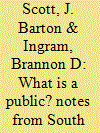

|
|
|
|
|
| Summary/Abstract |
In South Asia, as elsewhere, the category of ‘the public’ has come under increased scholarly and popular scrutiny in recent years. To better understand this current conjuncture, we need a fuller understanding of the specifically South Asian history of the term. Toward this end, our discussion begins by considering more than two decades of scholarship that have worked to excavate this history. We propose that two principal methods or approaches—the genealogical and the typological—have characterised this scholarship. We then suggest, more in the mode of genealogy, that the category of the public has been closely linked to the subcontinental history of political liberalism. Finally, we discuss how the essays collected in this special issue challenge some of liberalism's key presuppositions about the public and its relationship to law and religion.
|
|
|
|
|
|
|
|
|
|
|
|
|
|
|
|